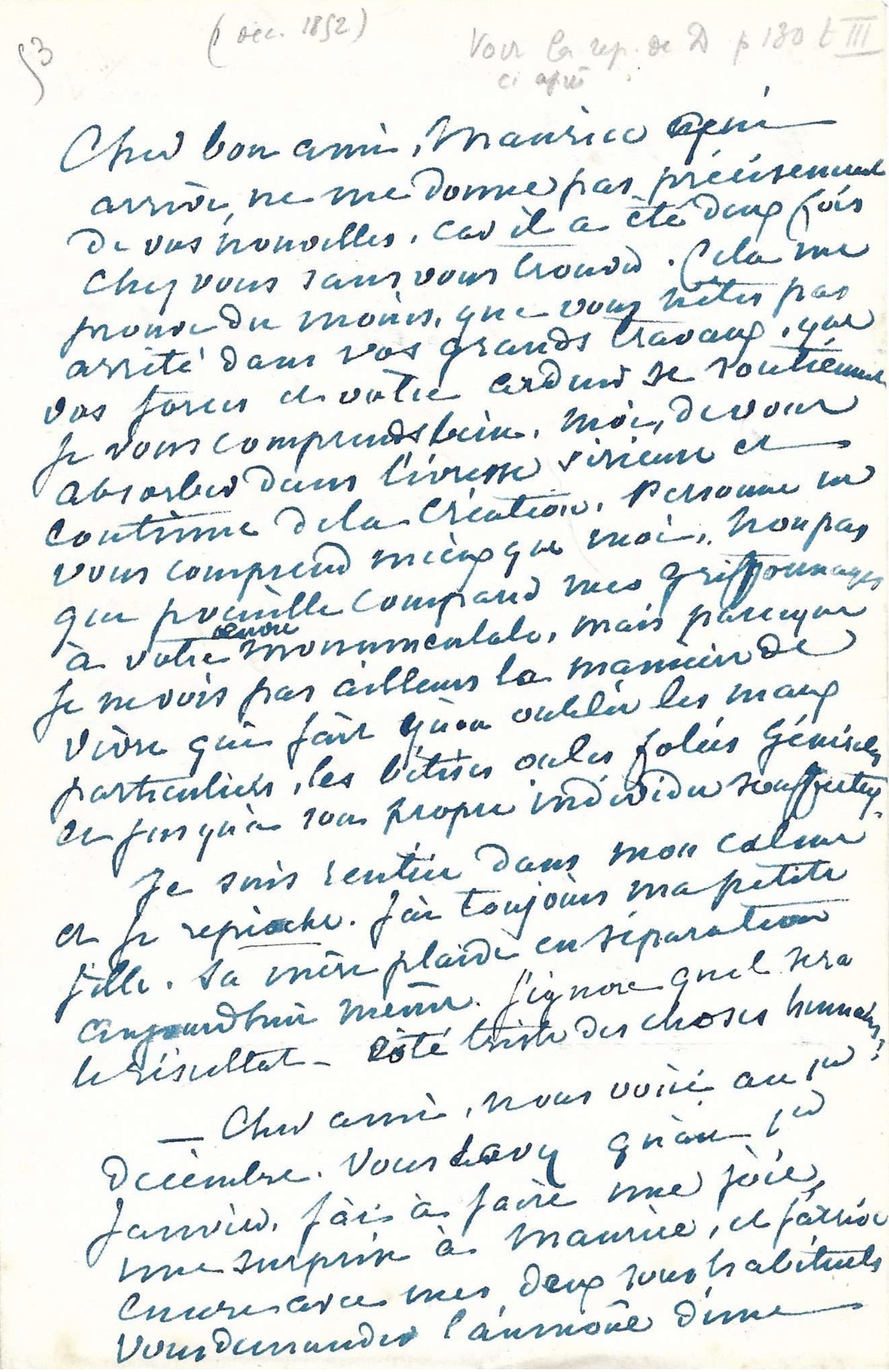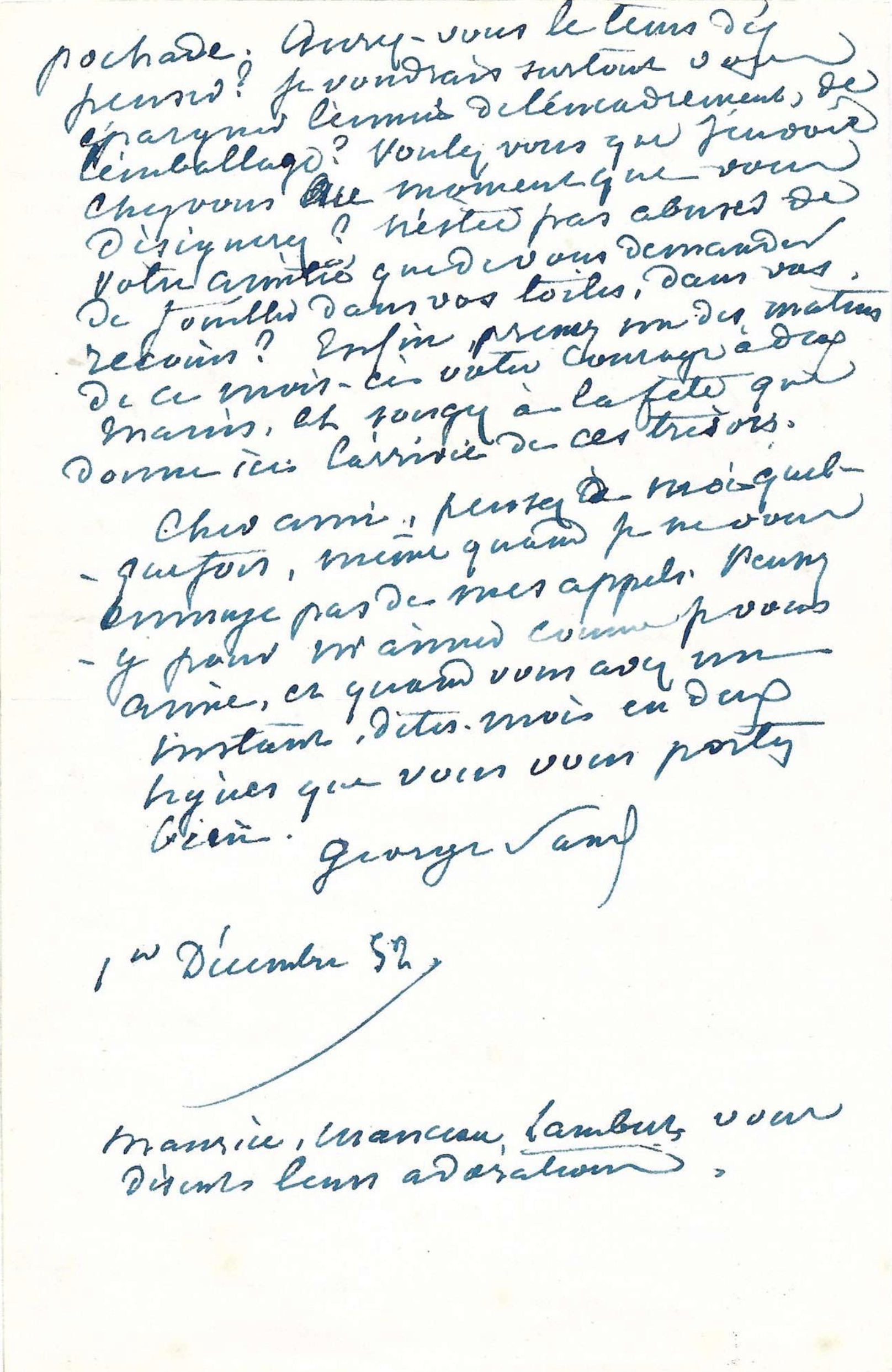[Eugène Delacroix] George Sand (1804.1876)
Autograph letter signed to Eugène Delacroix.
Two in-8 ° pages in blue ink.
Light trace of assembly on the fourth sheet.
[Nohant], December 1 [ 18] 52.
« I understand you, I absorb yourself in serious and continuous drunkenness of creation. No one understands you better than me. »»
Extraordinary testimony of the unwavering friendship between the novelist and the painter: Sand delivers all his admiration for Delacroix's painting and asks him for the gift of a canvas ( Lélia ).
__________________________________________________
" Dear good friend, Maurice [her son] who arrives, does not give me precisely your news, because he was twice at home without finding you. This proves to me at least that you are not stopped in your major works, that your strengths and your ardor support. I understand you, I absorb yourself in serious and continuous drunkenness of creation. No one understands you better than me; Not that I want to compare my scratches to your monumental work, but because I do not see elsewhere the way of life which makes us forget particular ailments, nonsense or general follies and to its own suffering individual.
I got back in my calm and reipoche. I always have my granddaughter. His mother pleads in separation today. I don't know what the result will be - on the sad side of human things!
Dear friend, here we are in 1 . You know that in January 1 , I have to delight, a surprise in Mauritius, and I still arrive with my two sos usual to ask you for the alms of a Pochade . Will you have time to think about it? Above all, I would like to spare you the boredom of the supervision, the packaging? Do you want me to send you to your home when you designate? Is it not to abuse your friendship to ask you to search in your fabrics, in your corners? Finally, take one of the mornings of this month your courage in both hands, and think about the party that gives here the arrival of these treasures.
Dear friend, think of me sometimes , even when I don't mind my calls. Think about it to love me as I love you , and when you have a moment, tell me in two lines that you are well. George Sand. December 1 , . Maurice, [Alexandre] Manceau, [Eugène] Lambert tell you their adorations. »»
__________________________________________________
George Sand returns from Paris on October 27, while his son Maurice was returned a month later, November 29. Having been unable to meet the master at his workshop (Delacroix was then in full wall decoration at the Salon de la Paix at the town hall of Paris), Maurice shares his mother. It is therefore on December 1 that the novelist decides to take the pen to declare all her love to the art of her friend.
Delacroix replied a week later: " Yes, expensive, I will send you something, and this is something that you have already liked and you had seen . It's a little surprise I wanted to make in Mauritius and you. So you will allow me to send brokes to this child that I love as much as I love. The subject is the same that you already have in pastel or watercolor: Lélia in the cave etc. […] The sight of a letter of you is a ray of happiness and it has always been so: never the smallest bitterness has spoiled this pure feeling: you take me with small fans that are the effect of my little health and my nerves, and you disentangle through it the deep feeling that attaches me to you ... "
In addition, Delacroix's remark - " The subject is the same as you already have in pastel or watercolor : Lélia in the cave" - recalls that George Sand already has two works by Delacroix dealing with the same subject.
Unlike Cleopatra , paid two hundred francs by George Sand the previous year, Lélia is a gift from Delacroix, and humbly dedicated " to Mauritius and you" . It is a small oil on canvas (24 × 18 cm). The scene, inspired by the second version of the novel by George Sand (1839) represents "Lélia in the cave of the monk in front of her lover's body".
Included in the Donation A. Lauth-Sand in 1923, the pastel is at the museum of romantic life (J. 1995, n ° 18-inventory n ° D89.73)
On December 30, George Sand writes : “ This superb and loved arrived this evening. I had it opened in the room with mystery, because I hold on the day of surprise, according to the old US. So I enjoyed it alone ... "
Sand also refers to family affairs: August 31, 1852 was pronounced before the court of first instance of the Seine the judgment of separation of the body of the key spouses (Solange Celesinger-Sand, daughter of George Sand, and Auguste Keysinger). At first, Jeanne-Gabrielle, known as Nini, their child, is entrusted to George Sand. Solange arrived in Nohant on January 5, 1853 and stayed there until February 12. This is undoubtedly here the request for separation of goods. On January 28, keys, appeal from the judgment of August 31, 1852. Sand was very attached to Nini, but the child died shortly after the separation of his parents, in Paris on January 14, 1855 of a poorly treated scarlatin.
This letter testifies to the unwavering friendship between the novelist and the painter. Begun in 1834, it ended with the death of Delacroix in 1863.
__________________________________________________
Origin :
Achille Piron (Universal legatee of Delacroix)
Marc Loliée Library
Bibliography:
George Sand - Correspondence , Lubin, t. XI, p. 486-487, letter n ° 5729.
Sand-Delacroix-Correspondence , ed. Françoise Alexandre, p. 195.


